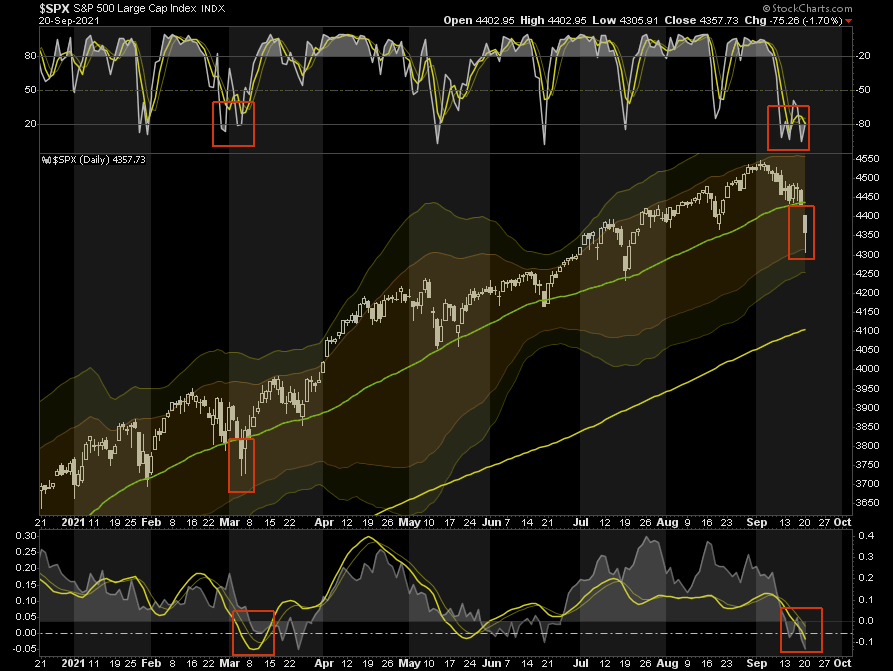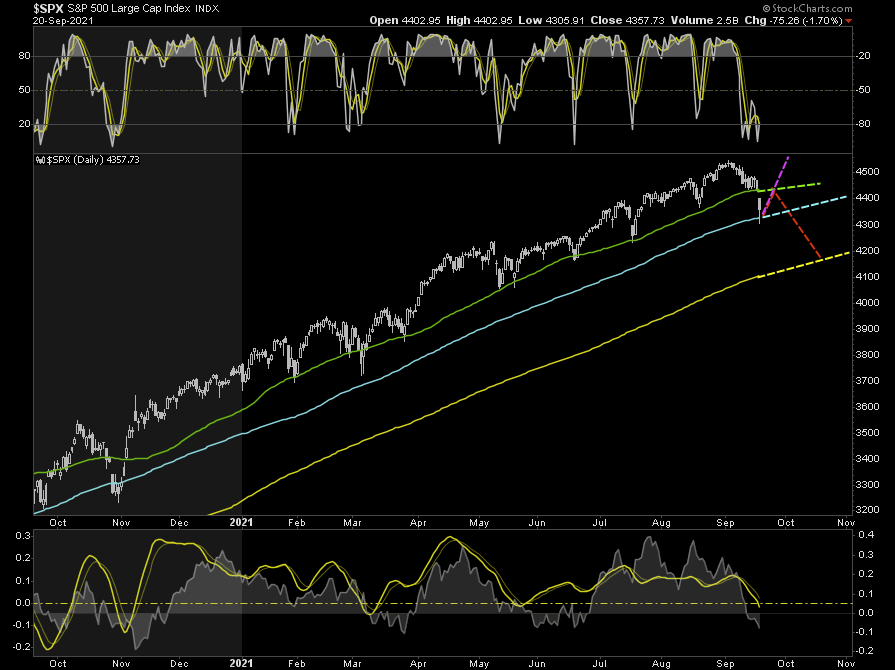On Monday, stocks solidly cracked below the 50-dma, but the bounce off the lows has investors asking if it’s “time to buy?”
The sell-off was not unexpected. As I discussed in “Investors Fail To Buy The Dip:”
“We can attribute the weakness on Friday to ‘quadruple witching,’ where every type of option (stock index futures, stock index options, stock options, and single stock futures) all expired simultaneously.
However, history is also not on the market’s side, with the S&P 500 averaging a 0.4% decline for September, the worst of any month, according to the Stock Trader’s Almanac. Friday, in particular, began a historically weak period for stocks as those September losses typically come in the back half of the month.
Also, the markets are a bit nervous about the Fed’s meeting next week with an announcement of “tapering” asset purchases expected.
With the market very oversold, a counter-trend bounce next week will not be a surprise. However, if the market fails to hold the 50-dma, the risk of a more substantial correction is likely.“
I have updated the chart below for Monday’s close. Note the similarity to the March period where the market closed well off its lows for the day. That bounce off the lows came with similar oversold conditions.
The decline on Monday was not a surprise as we have discussed the need to “carry an umbrella.”
Why We Carry An Umbrella
We slowly decreased “risk” and adjusted holdings for the last several weeks to prepare for an eventual downturn.
“As we discussed with our RIAPRO subscribers, our goal is to reduce the “volatility” of the portfolio, thereby reducing risk without significantly sacrificing performance.
We still hold a slightly higher cash balance in the equity sleeve (~10%) and the fixed income sleeve (~10%). We use the cash as a risk hedge against an equity draw and “shorten duration” in the bond allocation. While we were previously increasing the duration of our bond portfolio to capture the decline in rates, we are holding cash to add longer-duration bonds on upticks in rates.”
While those actions did not entirely shield our portfolios for such a steep and swift correction, those actions did limit the damage considerably. In addition, such allows us to use the correction to “buy assets” that are now oversold and have an improved “risk vs. reward” profile.
Such is the advantage of “risk management” versus a “buy and hold” strategy. You can’t “buy cheap” if you don’t have any cash to “buy” with.
Stocks Bounce, Is It Time To Buy?
The question on everyone’s mind is simplistic.
“Since stocks bounced, is it time to buy?”
As shown in the chart above, it is a difficult question to answer.
- On one hand, the market has reached more extreme oversold conditions, sentiment is increasingly bearish, and the longer-term bullish trends remain intact. Such bodes well for a bounce.
- Conversely, the market did break a key support level, is still well above the longer-term moving average, and internal indicators remain exceptionally weak. Such suggests any rally could fail short-term.
That statement may seem “wishy-washy,” however, the simple truth is I don’t know with certainty.
My best guess is the market likely gives us a one to two-day rally back to the 50-dma, which should get used to rebalance portfolio risk. However, if the market fails at that level, I suspect the market will continue the corrective action, and a test of the 200-dma is likely (red dashed line.)
On the other hand, if the market can muster a rally above the 50-dma, then an attempt at all-time highs is possible (purple dashed line).
As I said, it’s the best guess at two potential outcomes.
Patience Likely Needed
No. This is LIKELY NOT a buying opportunity for longer-term investors, people near retirement, or individuals who pay little attention to their investments.
For short-term traders, speculators, and opportunistic positioning, I suspect we are close to a bottom.
Regardless, the next buying opportunity will come. However, multiple issues are weighing on the market currently, to which investors need some clarity.
- China’s “Lehman Moment” with Evergrande
- The Fed meeting on Wednesday and risk of “taper.”
- Declining consumer sentiment
- Weakening economic growth
- A sharp reduction in global liquidity.
- Increasing warnings on corporate earnings
- Debt ceiling debate
- Treasury funding and potential default worries.
Some of these issues will get solved in short order. Others won’t. I suspect the Federal Reserve will likely provide “dovish” guidance on Wednesday, which will give some relief to the market.
Therefore, we continue to suggest using rallies to rebalance risk accordingly.
Navigating Whatever Comes Next
The purpose of the analysis above is to provide you with information to make educated guesses about the “probabilities” and “possibilities” over the following days and weeks.
It is absolutely “possible” the markets could find a reason to rally back to all-time highs and continue the bullish trend. (For us, such would be the easiest and best outcome.)
However, the analysis currently suggests the risks now outweigh the potential reward, and a deeper correction remains a distinct possibility. Such is particularly the case if the Fed takes a more “hawkish” stance.
While we remain optimistic about the markets currently, we are also taking precautionary steps to tighten up stops, add non-correlated assets, hold extra cash, and hedge risk opportunistically on any rally.
There is never any harm in reducing risk opportunistically and being pragmatic about your portfolio and your money.
Portfolio Actions To Take Now
Here are the rules that we will continue to follow over the next few days and weeks.
- Move slowly. There is no rush in making dramatic changes. Doing anything in a moment of “panic” tends to be the wrong thing.
- If you are over-weight equities, DO NOT try and fully adjust your portfolio to your target allocation in one move. Again, after big declines, individuals feel like they “must” do something. Think logically above where you want to be and use the rally to adjust to that level.
- Begin by selling laggards and losers. These positions were dragging on performance as the market rose and they led on the way down.
- Add to sectors, or positions, that are performing with, or outperforming the broader market if you need risk exposure.
- Move “stop-loss” levels up to recent lows for each position. Managing a portfolio without “stop-loss” levels is like driving with your eyes closed.
- Be prepared to sell into the rally and reduce overall portfolio risk. There are a lot of positions you are going to sell at a loss simply because you overpaid for them to begin with. Selling at a loss DOES NOT make you a loser. It just means you made a mistake. Sell it, and move on with managing your portfolio. Not every trade will always be a winner. But keeping a loser will make you a loser of both capital and opportunity.
- If none of this makes any sense to you – please consider hiring someone to manage your portfolio for you. It will be worth the additional expense over the long term.
Everyone approaches money management differently. Such is just our approach to the process of controlling risk.
We hope you find something useful in it.





